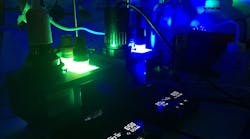A new method to create the primary amines essential for some pharmaceuticals uses an enzyme activated by blue light to reduce energy, waste and the number of reaction steps necessary, report researchers based at the University of Bath, Bath, U.K.
“Our new process synthesizes α-trisubstituted primary amines using only one step, a goal that has eluded chemists for many years. We’re really excited that our group is the first in the world to achieve this breakthrough,” says Alex Cresswell, a Royal Society University Research Fellow in Bath’s Department of Chemistry.
The researchers tested their new method on the synthesis of the Novartis’ multiple-sclerosis drug Fingolimod, which has annual sales of $3 billion. It reduced to just two steps the five currently used in the manufacturing process. A similar eight-step synthesis was reduced to a one-pot process.
As described in an article in a recent issue of the Journal of the American Chemical Society, the process operates at 25°C using a 425-nm LED lamp and 2,4,6-tris(diphenylamino)-3,5-difluorobenzonitrile (3DPA2FBN) as the enzyme.
Cresswell expects the rise in popularity of α-tertiary amines such as azaspirocycles in drug discovery will lead pharmaceutical makers increasingly to adopt the new reaction over the next 5–10 years as they gain more experience with photochemical technologies.
“It might translate into drugs based on that technology in 10–15 years’ time,” he adds.
AstraZeneca, Syngenta, GSK and Janssen Industrial are supporting the work through four-year PhD grants. In addition, two other (unnamed at the moment) companies shortly will invest £80,000 (about $109,000) each in the research program.
Moreover, AstraZeneca has stated its willingness to provide the group with complex molecules or advanced intermediates on which to test the new chemistry.
Back in the laboratory, part of the focus with Syngenta is on scaling up a continuous flow version of the process to about 100 g/d to better understand the technical aspects involved.
“For photochemistry, one of the best solutions for scale-up — from 100 g to 1 kg, for example — is to run the reaction in continuous flow in order to mitigate issues with poor light penetration in batch mode,” explains Cresswell.
The current set-up uses a commercial system in which powerful LEDs shine onto a cooled coil of transparent tubing through which the reaction mixture flows (Figure 1).
“If we chose to, we could increase capacity further by using industrial photoreactors designed for production scale,” he concludes.
